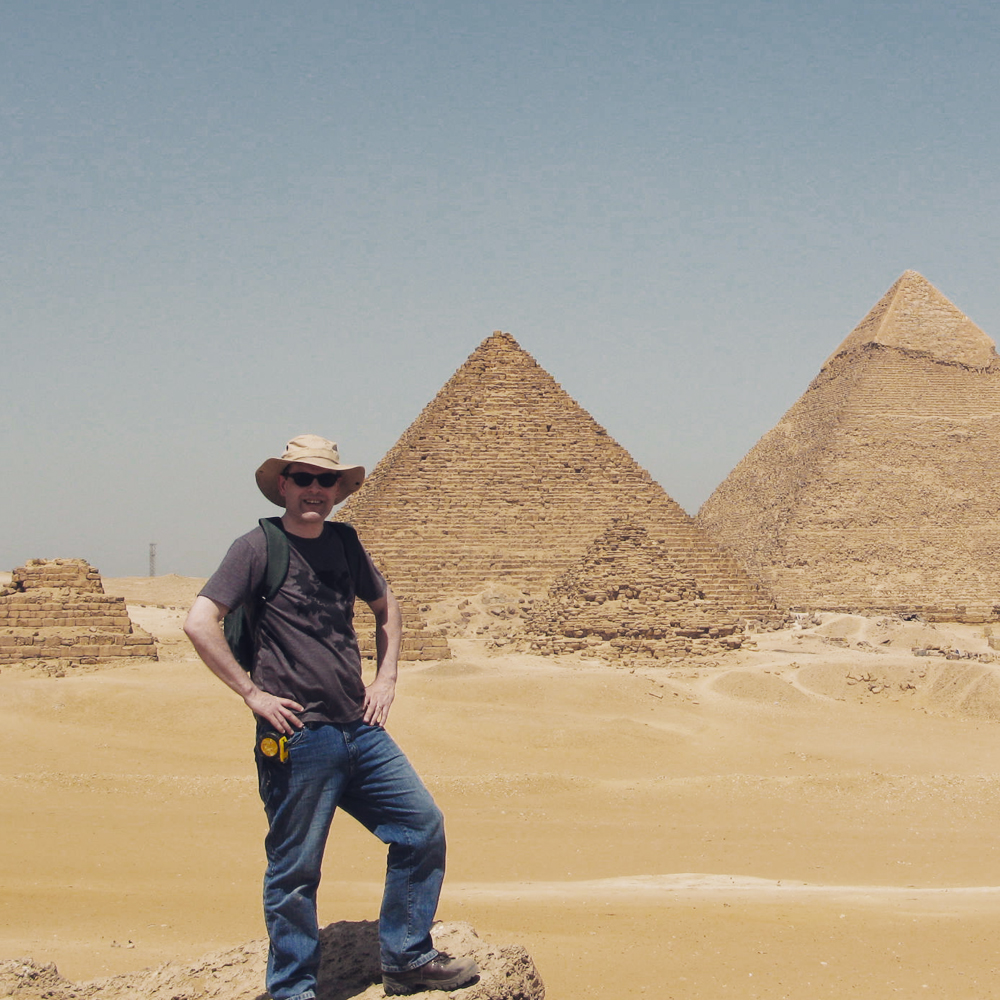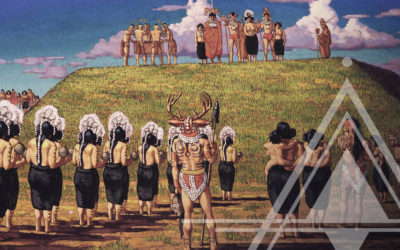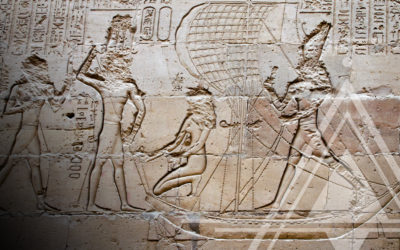Scott Creighton
The Brother of Suphis Mystery
Aug 10
Scott Creighton
Tags
However, one of Egyptology’s best defenses against the fraud theory with regards to these painted marks comes from the fact that not one but two different cartouches were allegedly found by Colonel Vyse within the sealed hidden chambers he discovered and blasted open.

Today Egyptologists insist that these two cartouches belong to the same ancient Egyptian king and that the name Suphis (figure 1, upper) is merely a shortened version of the second cartouche, Sen-Suphis (figure 1, lower). However, this was not known in Vyse’s time when it was believed by scholars that these two slightly different cartouches belonged to two quite separate kings. So why, the Egyptologists ask, would Vyse risk drawing scrutiny to his alleged discovery by placing what was believed at the time to be the cartouches of two kings within these chambers? And why two cartouches when placing just one cartouche in the chambers would have drawn less attention and would have just as easily served his purpose?
On the surface this seems a fairly compelling argument against any fraudulent activity having been perpetrated by Vyse and that for Vyse to have actually done this would require some compelling reason(s) for him to do so. However, when we consider the detail of the situation, things are not so clear cut and what we find instead is that there are a number of possible scenarios that could indeed have compelled Vyse to place both of these cartouches within the chambers he discovered.
In 1837 when Vyse first embarked upon his explorations at Giza, the state of knowledge of ancient Egypt – particularly with regards to the reigns and succession of its kings – was somewhat vague. This situation is described by Vyse himself in his subsequent book, in which he writes:
- Herodotus (484 BC): Cheops, Cephrenes and Mycerinus
- Manetho (300 BC): Suphis I, Suphis II and Mencheres
- Eratosthenes (276 BC): Saophis I, Saophis II (or Sensaophis) and Moscheres
- Diodorus (90 BC): Chembes (or Chemnis), Kephren and Mycerinus (or Mecherinus)
So, although the various names (and spellings thereof) of the pyramid builders had been known for millennia, it was not until 1832 AD that the Italian scholar, Ippolito Rosellini, became the first person to identify and publish the ancient Egyptian royal cartouche belonging to the builder of the Great Pyramid, identified as #2 in figure 2.

So we must ask then, if Vyse did perpetrate a fraud within the Great Pyramid, why would he place—what should have been clear to him at the time—the cartouches of not one but two different kings (two brothers) into the hidden chambers i.e. Suphis and Sen-Suphis? Indeed, the Egyptologists argue, for Vyse to have known, in 1837, that these two cartouches were not of brothers but actually belonged to the same king (as is the accepted view today) would have made him the foremost scholarly authority of his day, exceeding the knowledge of renowned academics such as Wilkinson and Rosellini.
So how could an amateur such as Vyse have confounded the experts of his day and acquire for himself the necessary knowledge to pull off such an audacious, convincing and lasting fraud? The simple truth of the situation is that in 1837 there was, in fact, sufficient published information already in the public domain that could have allowed Vyse to obtain the knowledge that would then have compelled him to place both cartouches within the ’Vyse Chambers’ of the Great Pyramid, albeit for erroneous reasons. And all of the necessary books may well have been easily accessible to Vyse during his time at Giza in 1837 since the British vice-consul to Egypt, Dr Alfred Septimus Walne, founded the Egyptian Society in Cairo in that year.
We will now consider a few hypothetical scenarios explaining why Vyse might have felt compelled to place these two different cartouches into the chambers he had discovered.
First of all, one of the interesting things the ancient historians tell us of Suphis and Sensuphis (Suphis II) is the great length which they each reigned. Herodotus gives us reigns of 50 and 56 years respectively, whereas Manetho gives reigns of 63 and 66 years respectively. Such lengthy reigns has led a number of later commentators to take the view that these two kings must have reigned together in a co-regency. Where Vyse, in 1837, to have considered the lengths of the reigns of these two kings as given by Herodotus and Manetho then it becomes conceivable that he may also have come to the view that these kings were likely to have been co-regents. Coming to such a realization there would then have been every reason for Vyse to have placed the cartouches of both kings within the chambers.
Secondly, in Vyse’s time it was believed (via the historian and Bishop, Eusebius) that it was Suphis II (Sensuphis) who built the Great Pyramid. And so, if Vyse had read and accepted this remark given by Eusebius then this would easily explain his placement of the Sensuphis cartouche within the first three chambers that he opened. However, in the fourth and final chamber opened by Vyse we find only the Suphis/Cheops cartouche. What this may indicate is a late change in mind by Vyse i.e. that he now believed that the structure had been built by Suphis/Cheops and so he places only the Suphis cartouche within the final chamber. However, he could hardly remove the Sensuphis cartouches he had previously placed in the chambers below as these had already been independently witnessed upon the walls by others out with his team with copies of them having been sent to the British Museum. Admittedly this possibility is much less likely to have influenced Vyse since, Eusebius aside, the prevailing view in Vyse’s time was that Suphis built the Great Pyramid.
A third possible scenario arises from a study of the cartouches and texts in the academic books available to Vyse in 1837. One of the first questions that almost certainly would have crossed Vyse’s mind with regards to the cartouche of Sen-Suphis presented in these early Egyptology books would have been why this cartouche was being interpreted as ‘Brother of Suphis’? Is this even a name? Vyse could reasonably have pondered why any self-respecting ancient Egyptian king would have been named at birth (or perhaps when ascending the throne) as ‘Brother of Suphis’; ‘brother of some other person’? Surely this ‘brother’ of Suphis must have had a name of his own and, if so, what was it?
In pursuance of this particular question, Vyse could have then considered the names the Greek historian, Herodotus, gave as the builders of these monuments, namely: Cheops, Cephrenes and Mycerinus. But as we have seen, according to Manetho, we have the names Suphis, Suphis II (or Sen-Suphis) and Mencheres as the pyramid builders. Thus today, scholars have translated Manetho’s ‘Suphis’ as the ‘Cheops’ of Herodotus, Sen-Suphis as Cephrenes and Mencheres as Mycerinus.
But these same scholars also translated ‘Sen’ to mean ‘brother’ and, as such, we must ask the obvious question: why do we not find in the list of Herodotus the name ‘Sen-Cheops’ (as analogous to Manetho’s ‘Sen-Suphis’) as the ‘brother of Cheops/Suphis’? Instead, Herodotus presents us with Cepherenes as being the brother of Cheops; a name that, for obvious reasons, we cannot expect could also translate into Suphis or Sen-Suphis. This is to say that a name in one language is unlikely to translate into two different names in another language i.e. ‘Suphis’ cannot translate into both ‘Cheops’ and ‘Cephrenes’.

But who?
Well, first of all, there’s a very big clue to answering this question which Vyse could not have failed to notice – both cartouches present the name ‘Suphis’. Secondly, the answer to this particular mystery may have presented itself to Vyse from information that was already publicly available long before he ever embarked on his journey to Egypt in late 1836.
In his 1828, Materia Hieroglyphica, John Gardner Wilkinson writes the following:
That the other oval, or prenomen, always contains a title, derived from the name of one, or more deities, which serves to point out more particularly the king, to whom both the ovals belong.
That these prenomens, or titles being sometimes mentioned together with the nomens, have led to that disagreement, which exists amongst ancient scholars, in the names of the kings; they have confounded the prenomens with the nomens, or mistaken the one for the other… for it does appear in a few instances that Manetho has introduced both the nomen and the prenomen.
And so, once more, upon reading the above passage from Wilkinson, and then by a study of the characters presented in the Suphis and Sen-Suphis cartouches, it is conceivable that Vyse, in consideration of the available published texts from his time, could quite easily have concluded that these two slightly different cartouches were but the nomen and prenomen of the same ancient Egyptian king and, consequently, decided that both cartouches should be copied into the hidden chambers he had blasted his way into within the Great Pyramid.
And the rest, as they say, is history.
References
- Vyse, Col R.W. Howard, Operations Carried on at Gizeh in 1837, volume I, p.94.
- Manetho gives no indication as to who built the second pyramid, only the first and third pyramids. The assumption is that Manetho’s Suphis II built the second Giza pyramid.
- Rosellini, Ippolito, I’Monumenti dell’Egitto e della Nubia, volume I, p.128.
- Wilkinson, Sir John Gardner, Materia Hieroglyphica, volume II, p.74.
- Rosellini, Ippolito, I’Monumenti dell’Egitto e della Nubia, volume I, p.130.
- The Literary Gazette, Volume 20, 1836.
- Osburn, William, The monumental history of Egypt,p.281-282.
- This belief held by Eusebius may have been the result of a confusion in the actual names of the Giza pyramids. The ancient name of the Great Pyramid is given as ‘Akhet-Khufu’ (Khufu’s Horizon) whereas the name of the second pyramid at Giza was known in ancient times as Khafre Wer (Khafre is Great). (See ‘Mountains of the Pharaohs’, Zahi Hawass, p.116).
- Vyse, Col R.W. Howard, Operations Carried on at Gizeh in 1837, volume I, p.94.
- Wilkinson, Sir John Gardner, Materia Hieroglyphica, (Extracts), volume II, p.3-4.
- Modern Egyptology actually asserts that these two cartouche are not nomen and prenomen but rather that the Sen-Suphis cartouche (which translates into Egyptian hieroglyphicsa as ‘Khnum-Khuf’) is nothing more than the full birth name of the Suphis (Khufu) cartouche.
- Wilkinson, Sir John Gardner, Materia Hieroglyphica, (Extracts), volume II, p.4-5.
- In 1878 the name ‘SenSuphis’ (Brother of Suphis) was abandoned by Samuel Birch in favour of Suphis II (See The Manners and Customs of the Ancient Egyptians, Wilkinson – New Edition Revised and Corrected by Birch, p.273).

About the Author
You May Also Like
Join Our Mailing List
Spam sucks. We take your privacy seriously and we will never spam your inbox. You can opt out at any time.




